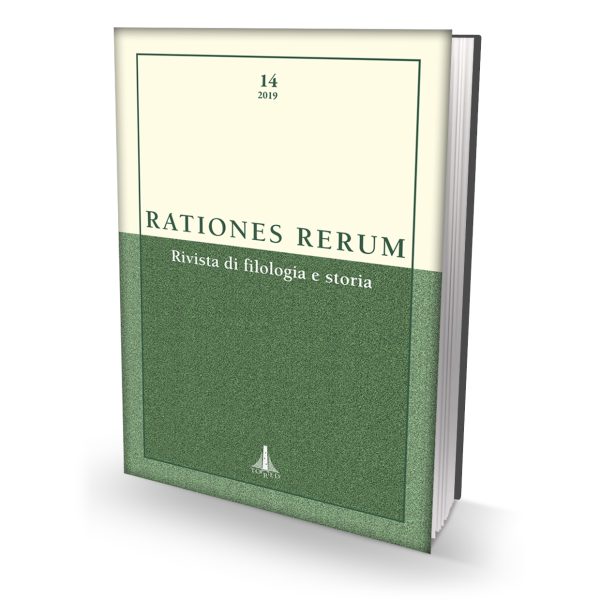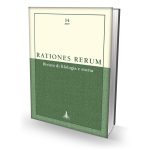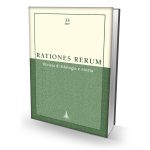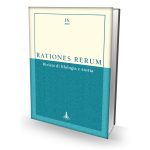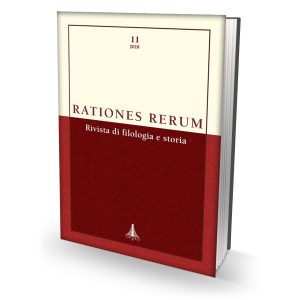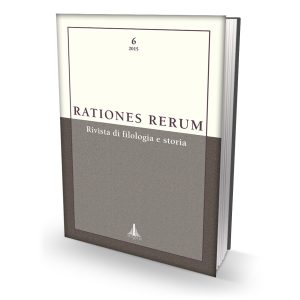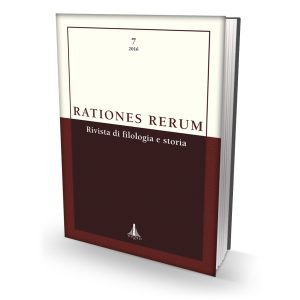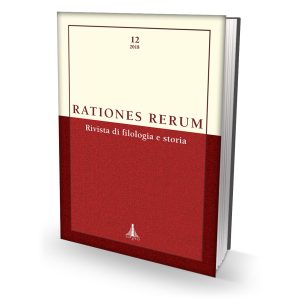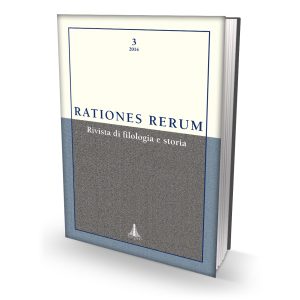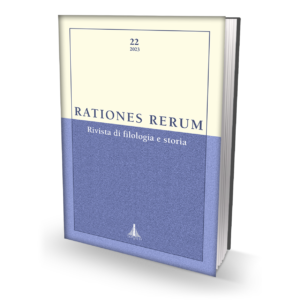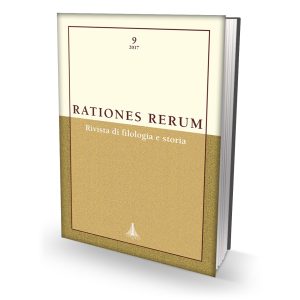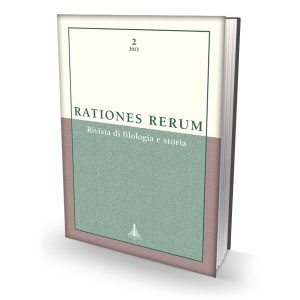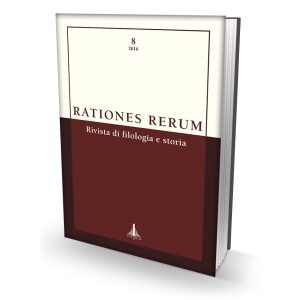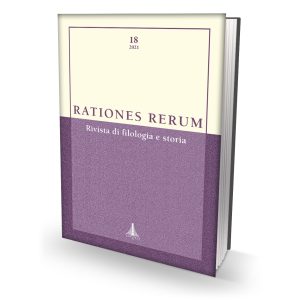RATIONES RERUM 14 – Rivista di filologia e storia
50,00 €
Autori vari
Anno edizione: 2019
Formato 17×24 – Pagine 336
Confezione a filo refe in brossura
Copertina plastificata con bandelle
ISBN 9788899846480 – ISSN 2284-2497
Prezzo: € 50,00
- Descrizione
- ANTEPRIMA
- ABSTRACTS
Descrizione
Sommario
LATIN GRAMMARIANS FORUM 2018-2019
a cura di Anna Chahoud, Michela Rosellini, Elena Spangenberg Yanes
Anna Chahoud, Presentazione, p. 9
Andrea Bramanti, Le ragioni di un’edizione sinottica: il rapporto tra il secondo libro delle Artes di Sacerdote e i Catholica Probi, p.13
Mario de Nonno, Note critiche al testo dei Grammatici Latini. 1: L’Ars grammatica di Diomede, p. 33
Alessandro Garcea, Diomedes as a Source for Pliny’s Dubius sermo: Some Editorial Problems, p. 53
Stefano Poletti, La semantica di ruo nell’esegesi virgiliana antica. Note critiche a Serv. Georg. 2, 308 ed Aen. 2, 250, p. 73
Michela Rosellini, Nomina generis dubii in Servio, p. 93
Tommaso Mari, Corruzione testuale in un’opera sulla corruzione linguistica: il De barbarismis et metaplasmis di Consenzio, p. 113
Tommaso Mari, Foni e terminologia fonetica nel De barbarismis et metaplasmis di Consenzio: il caso della i, p. 127
Anna Zago, The (New) Prologue to Pompeius’ Commentum, p. 141
Elena Spangenberg Yanes, Non-Mechanical Omissions: an Insight into the Early Stages of Priscian’s Transmission, p. 193
Adam Gitner, Imagining an Archetype of the Idiomata generum, p. 221
Claudio Giammona, Un’Orthographia visigotica? Osservazioni sulla tradizione manoscritta dell’Orthographia Bernensis I, p. 239
Michela Rosellini – Elena Spangenberg Yanes, Per un Thesaurus Dubii Sermonis digitale, p. 259
Bibliografia generale, p. 291
Abstracts, p. 329
Istruzioni per gli autori, p. 335
Andrea Bramanti,
Le ragioni di un’edizione sinottica: il rapporto tra il secondo libro delle Artes di Sacerdote e i Catholica Probi
pp. 13-32
The second book of Sacerdos’ Artes and its parallel and stand-alone copy, Ps. Probus’ Catholica, preserve interesting traces of reuse in an anonymous tradition. By analyzing some selected passages from these two texts, the present contribution aims at evaluating the nature of their relationship and demonstrating that a synoptic edition is the only editorial option for producing the most faithful representation not only of what Sacerdos wrote but also, in certain cases, of how the work of this third century Ad grammarian has most likely been manipulated in the schools of Late Antiquity.
Mario De Nonno
Note critiche al testo dei Grammatici Latini. 1: L’Ars grammatica di Diomede
pp. 33-51
Exegetical and textual notes to seven passages in diomedes’ lengthy Ars grammatica, edited by H. KeiL, Grammatici Latini, i, Lipsiae 1857. In the reconstitution of the text, due attention is paid to the recognized presence of late Latin prose rhythm. emendations are proposed to GL 1 p. 299, 18-23; p. 309, 22-24; pp. 430, 29 – 431, 9; p. 488, 14 ff.; p. 499, 2-6; p. 502, 20-28; pp. 518, 32 – 519, 8. This is the first installment of a projected series of articles aimed at scrutinizing many of the grammarians edited by Keil in his comprehensive corpus.
Alessandro Garcea
Diomedes as a Source for Pliny’s Dubius sermo: Some Editorial Problems
pp. 53-71
This article provides a study of diomedes’ treatment of verbs quae R littera finiuntur (GL 1 374, 23 – 377, 20). This analysis includes two passages where Pliny’s Dubius sermo is explicitly quoted (frg. 110 and 119 Della Casa = 107 and 110 Mariotti²), but other material deriving from Pliny can reasonably be identified, thanks to quotations from non-literary authors who are explicitly used as sources for the Naturalis historia or for other works not studied in school and quoted elsewhere in the Dubius sermo. The parallels between these passages from Diomedes and those from Priscian, who explicitly draws on Caper, show that the latter was probably the intermediary through whom the learned study of grammar from the first and second centuries AD was transmitted to late Latin scholars.
Stefano Poletti
La semantica di ruo nell’esegesi virgiliana antica. Note critiche a Serv. Georg. 2, 308 ed Aen. 2, 250
pp. 73-91
This article analyzes two Servian scholia on syntactical and semantic peculiarities of the verb ruo. The first critical note (Serv. Auct. Georg. 2, 308 et ruit atram) focuses in particular on matters of textual reconstruction; the second one (Serv. Aen. 2, 250 ruit Oceano nox) thoroughly investigates a series of thorny interpretive problems that have so far been neglected by modern virgilian commentators.
Michela Rosellini
Nomina generis dubii in Servio
pp. 93-111
This article collects and analyzes some passages in which Ser vius, in his Commentaries on vergil’s works, deals with questions of grammatical gender. The research aims to see how much interest Ser vius had in this topic, which doctrinal and didactic principles guided him, which sources he had available and made use of, and to which ling uistic auctoritates he ascribed value on this subject. Ser vius (much more than the so-called Ser vius danielis) deals frequently with gender topics, which in his own time were already a well-established field of Latin grammar, and quotes the works of Pliny the elder and Caper, the most famous authors De dubiis generibus; only a few of his obser vations seem independent of this large tradition. Moreover, occasionally he adds examples from recent poets (Lucan, Persius, Statius, iuvenal), whom he greatly appreciated and often quoted on other topics.
Tommaso Mari
Corruzione testuale in un’opera sulla corruzione linguistica: il De barbarismis et metaplasmis di Consenzio
pp. 113-126
Consentius’ De barbarismis et metaplasmis includes a lengthy discussion of errors in spoken Latin and thus provides us with a rich list of non-standard Latin forms. It is precisely the non-standard nature of these forms that caused trouble for medieval copyists, such that Consentius’ manuscripts have variae lectiones among which it is not always easy for a modern editor to choose. This paper focuses on textual problems concerning non-standard forms presented by Consentius, especially those involving metathesis and the use of the aspirate; it also discusses cases in which Consentius’ text seems secure but the interpretation of the form he presents is rather problematic, thus revealing some of the limits of his learning. The paper also analyzes the significance of the forms discussed for our understanding of “vulgar” or simply “non-standard” Latin.
Tommaso Mari
Foni e terminologia fonetica nel De barbarismis et metaplasmis di Consenzio: il caso della i
pp. 127-140
Consentius’ De barbarismis et metaplasmis includes a discussion of the correct and incorrect pronunciations of several sounds; the author describes the sounds discussed, but it is difficult at times to understand exactly the characteristics of the sounds being described because the phonetic terminolog y that was current in ancient grammar is not very precise. This article focuses on the phonetic terminolog y with which Consentius describes the errors in the pronunciation of the sounds of i, l, t, c, s, and u, and especially on the use of the terms pinguis and exilis. The case of the sounds of i is particularly interesting but also very complicated, for it presents textual as well as interpretive problems: Consentius describes both some pronunciation errors by Gauls and Greeks and also the correct pronunciation of i depending on two different criteria, its position within a word and its quantity; the latter partly foreshadows Romance developments.
Anna Zago
The (New) Prologue to Pompeius’ Commentum
pp. 141-192
This article presents a new critical edition of the prologue to the Commentum artis Donati written by the African grammarian Pompeius (5th century Ad). The very beginning of Pompeius’ work, unknown to Heinrich Keil and discovered by Louis Holtz in 1971, is edited here for the first time on the basis of a fuller knowledge of the manuscript tradition. The text is accompanied by a philological introduction, a translation, and a commentary.
Elena Spangenberg Yanes
Non-Mechanical Omissions: an Insight into the Early Stages of Priscian’s Transmission
pp. 193-219
As part of a larger collaborative research project for a new critical edition of the Ars Prisciani, this article investigates a particular feature of the manuscript transmission of the work. As other scholars (de nonno, Rosellini) have already pointed out with regard to specific witnesses or sections of the Ars, some codices omit (or, on the contrary, supply) whole sentences and passages of varying lengths, whose omission cannot be justified either as the result of a mechanical error such as a saut du même au même or of material damage. Based on a complete survey of peculiar omissions of this kind in all 8th-9th-century Ad witnesses of the Ars and on the most recent progress in the re- construction of the stemma codicum for some books of the Ars, this article casts light on some aspects of the composition process of Priscian’s major work, as well as of its early transmission.
Adam Gitner
Imagining an Archetype of the Idiomata generum
pp. 221-238
This article surveys the corpus of bilingual Idiomata generum as a genre and addresses several issues preliminary to an edition of these works. first, to what extent an archetype can be reconstructed, at least for part of the tradition, among the individual witnesses (the Anonymus Bobiensis [Naples BN Lat. 2]; Charisius [Naples BN IV A 8]; and the Idiomata Parisina [Paris. Lat. 7530])? Secondly, what is their relationship to other lexical and grammatical sources?
Claudio Giammona
Un’Orthographia visigotica? Osservazioni sulla tradizione manoscritta dell’Orthographia Bernensis I
pp. 239-258
The Orthographia Bernensis I, so called from the manuscript Bern 522 used by Hagen for its edition, is a short collection of orthographical prescriptions, sorted according to the first letter, given the absence any other element that could provide a greater consistency; however, this text is transmitted almost unaltered in three other manuscripts, and a fuller version is preserved in six other manuscripts. This article presents a close examination of the differences between these two versions, and of the variants in each manuscript, in order to clarify the relations between them, suggesting an hypothesis on the original form of this text and on its background.
Michela Rosellini – Elena Spangenberg Yanes
Per un Thesaurus Dubii Sermonis digitale
pp. 259-290
The article addresses the problems in editing fragmentary Latin grammatical works. The first part of the contribution surveys the existing editions, focusing on their methodological limits, and analyzes some significant case-studies. Then it proposes a new model of collection (thesaurus) of the fragments of the Latin grammarians who dealt with dubius sermo and Latinitas: the collected texts will be edited in digital form and lexicographically arranged. The second part presents the criteria for the digital markup (based on the XML-TEI language) adopted in the project of the Thesaurus Dubii Sermonis.

